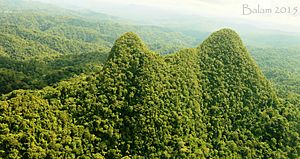Central American Atlantic moist forests facts for kids
Quick facts for kids Central American Atlantic moist forests |
|
|---|---|

Cerro Chachahuate
|
|

Ecoregion territory (in purple)
|
|
| Ecology | |
| Realm | Neotropical |
| Biome | Tropical and subtropical moist broadleaf forests |
| Borders |
List
|
| Geography | |
| Area | 89,979 km2 (34,741 sq mi) |
| Countries | Guatemala, Honduras and Nicaragua |
| Coordinates | 13°45′N 84°45′W / 13.75°N 84.75°W |
| Conservation | |
| Protected | 30.2% |
The Central American Atlantic moist forests are a special type of ecoregion found along the Atlantic coast of Honduras, southeastern Guatemala, and eastern Nicaragua. These forests are like giant green blankets covering the lowlands. They are mostly made up of tall, evergreen trees that stay green all year round.
These amazing forests are home to many different plants and animals. They also contain the largest single area of natural forest in all of Central America. This huge forest covers about 14,629 square kilometers (5,648 square miles). In total, the ecoregion covers about 89,979 square kilometers (34,741 square miles).
Contents
Where Are These Forests Located?
These forests stretch for about 700 kilometers (435 miles). They start near Lake Izabal in southeastern Guatemala. Then, they continue along the northern coast of Honduras in a strip about 50 kilometers (31 miles) wide. Finally, they spread across most of the eastern half of Nicaragua.
The land in this ecoregion is mostly low-lying. The average height above sea level is about 293 meters (961 feet). However, some parts can reach as high as 2,270 meters (7,448 feet).
What is the Climate Like?
The climate in these forests is called a Tropical monsoon climate. This means the temperatures stay warm all year long, usually above 18°C (64°F). There is also a clear dry season. During the driest month, there is less than 60 mm (2.4 inches) of rain.
This type of climate is a mix between a tropical rainforest and a tropical savanna. It gets a lot of rain, but not as much as a full rainforest. On average, the ecoregion receives about 2,333 mm (92 inches) of rain each year.
Plants and Animals of the Forest
More than half of this ecoregion is covered by dense, evergreen rainforest. The trees here can grow very tall, sometimes up to 50 meters (164 feet)! These forests are full of life.
Sadly, about 30% of this land has been changed into farms. Between 1990 and 2000, the forests were shrinking by almost 1% each year. However, there are still many large areas of untouched forest left. These big forest areas are very important for large animals. Big mammals, for example, need at least 100 square kilometers (39 square miles) of forest to live and thrive.
Protecting These Special Forests
It's great news that a good part of this ecoregion is officially protected. About 30.2% of the Central American Atlantic moist forests are safe within national parks and reserves. These protected areas help keep the plants and animals safe for the future.
Some of the important protected areas include:
- Agalta National Park
- Azul Meámbar National Park
- Blanca Jeannette Kawas National Park (Punta Sal)
- Bosawás Biosphere Reserve
- Capiro-Calentura National Park
- Cerro Azul National Park
- Cerro Saslaya National Park
- Chocón Machacas
- Cuevas de Silvino National Park
- Cusuco National Park
- Montaña de Botaderos Carlos Escaleras Mejía National Park
- Montaña de Yoro National Park
- Nombre de Dios National Park
- Omoa National Park
- Patuca National Park
- Pico Bonito National Park
- Pico Píjol National Park
- Punta Izopo National Park
- Port Royal National Park
- Río Dulce National Park
- Río Plátano Biosphere Reserve
- Santa Bárbara National Park
- Tawahka Asagni Biosphere Reserve
- Temash-Sarstoon National Park
See also
 In Spanish: Bosques húmedos del Atlántico centroamericano para niños
In Spanish: Bosques húmedos del Atlántico centroamericano para niños

